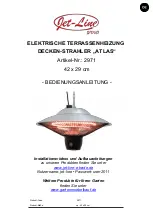
8
a) Be at least one pipe size larger than the normal outlet size of the safety device unless
its total equipment hydraulic resistance exceeds that of a straight pipe 9m long, i.e.
discharge pipes between 9m and 18m equivalent resistance length should be at least
two sizes larger then the normal outlet size of the safety device, between 18m and 27m
at least three sizes larger and so on. Bends must be taken into account in calculating
the flow resistance. Refer to Figure 3, Table 1 and Calculated Example 1.
b) Have a vertical section of pipe at least 300 mm long below the tundish before any
elbows or bends in the pipework.
c) Be installed with a continuous fall.
d) Have discharges visible at both tundish and the final point of discharge, but where
this is not possible or practically difficult, examples of acceptable discharge arrange-
ments are:
•
Ideally below a fixed grating and above the water seal in a trapped gully.
•
External surfaces such as car parks, hard standings, grassed areas, etc.) are
acceptable providing that where children play or otherwise come into contact
with discharges, a wire cage or similar guard is positioned to prevent contact
whilst maintaining visibility.
•
Discharge at high level, e.g. into a metal hopper and metal down pipe with the
end of the discharge pipe clearly visible (tundish visible or not) or onto a roof
capable of withstanding high temperature discharges of water and 3 m from any
plastic guttering system that would collect such discharges (tundish visible).
•
Where a single pipe serves a number of discharges such as in blocks of flats,
the number served should be limited to not more than six systems so that any
installation discharging can be traced reasonably easily. The single common
discharge pipe should be at least one pipe size larger than the largest individ-
ual discharge pipe to be connected. If unvented hot water storage systems
are installed where discharges from safety devices may not be apparent (i.e. in
dwellings occupied by blind, or disabled people), consideration should be given
to the installation of an electrically operated device to warn when discharge
takes place.
WARNING:
The discharge will consist of scalding water and steam. Asphalt, roofing
felt and non-metallic rainwater goods may be damaged by such discharges.






































